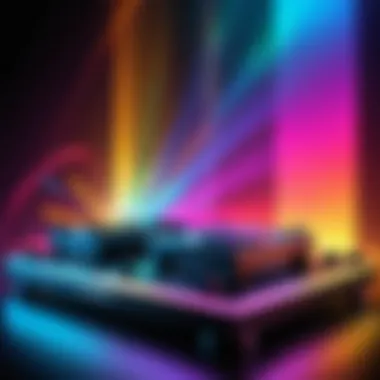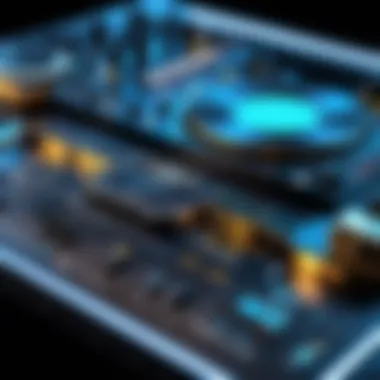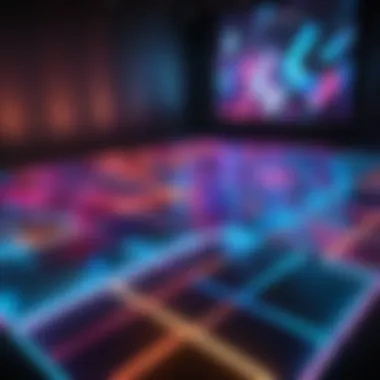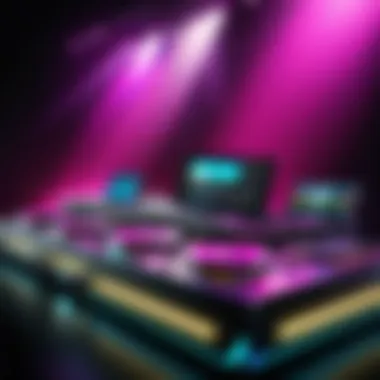Illumination Insights: The Impact of DJ Lighting on Events


Intro
The significance of professional DJ lights in enhancing the ambiance of modern events cannot be overstated. These lighting systems do more than merely illuminate; they create an atmosphere that amplifies the overall experience for attendees. In various gatherings such as weddings, concerts, and corporate events, the right lighting can transform a mundane setting into an engaging spectacle. Understanding how these systems work, their specifications, and their applications is crucial for anyone looking to elevate their event.
Technical Specifications
Detailed Product Specs
When selecting DJ lights, it is essential to examine the product specifications closely. Factors such as wattage, color range, lumens output, and power consumption provide insight into the potential performance of the equipment. For instance, higher wattage typically leads to brighter lights, while an extended color range allows for versatile effects. Additionally, models like the Chauvet DJ SlimPAR 64 offer compact designs while delivering high-quality output.
Performance Metrics
Performance metrics are critical in understanding how DJ lights operate in real-world conditions. These metrics include brightness measured in lumens, coverage area, and the speed of color transitions. A product like the Martin Rush MH 1 can cover large areas while maintaining a powerful brightness level, making it suited for larger venues.
Compatibility Information
Not all DJ lights work seamlessly with existing systems. Compatibility with DMX controllers or other lighting control systems is crucial for coordinated displays. Ensuring that lights can interface with audio equipment or software will enable synchronized light shows that elevate any performance. Always verify compatibility before making a purchase.
Practical Applications
Use Cases for Different Users
Different users benefit from varying applications of DJ lights. For mobile DJs, easy-to-transport units like the ADJ Pocket Pro may offer versatility suitable for various venues. Event planners can benefit from mixed unit sets allowing for customized lighting arrangements depending on the theme of the event.
Recommended Configurations
Each event type may require specific configurations. For example, a nightclub setting might use moving heads alongside LED bars for dynamic effects, whereas a wedding may lean towards softer uplighting with warm tones.
Multi-Platform Performances
DP users often engage across different platforms. Whether performing in a gym, on outdoor stages, or in intimate venues, understanding the light requirements ensures the atmosphere fits the expected vibe of the occasion.
Latest Trends
Industry Developments
Recently, the industry has seen a shift towards energy-efficient lighting options. LED technology continues to dominate, not only for its low power consumption but also for its adaptability in color and design.
Emerging Technologies
Emerging technologies like wireless LED systems provide greater flexibility. These systems eliminate the clutter of wires, allowing for easier setup and teardown, which is valuable for mobile DJs.
Future Predictions
Looking ahead, the integration of smart technology in DJ lighting will likely become the norm. Expect to see more lights controllable via apps and synchronization with other event technology, leading to more immersive experiences.
Buying Guides
Recommended Products
For those seeking reliable options, the QSC K12.2 loudspeakers accompanied by the Chauvet DJ Colorado 1-Tri IP may create a balanced audio-visual experience suitable for many events.
Purchasing Tips
When purchasing DJ lights, consider factors such as warranty, customer reviews, and return policies. It is wise to invest in equipment from reputable brands known for quality and service.
Warranty and Support Information
Check for warranty details and available customer support. A good warranty can save costs in the event of equipment failure, making it an essential factor in the buying process.
The right lighting can enhance not only the visual appeal of an event but also its overall atmosphere, influencing attendee engagement and enjoyment.


Understanding DJ Lighting
The realm of DJ lighting is not merely about making events look visually appealing. It serves a much larger purpose within the fabric of modern entertainment. By grasping the fundamentals of DJ lighting, one can appreciate its pivotal role in transforming ordinary events into memorable experiences. Lighting sets the atmosphere, enhances performances, and engages the audience on deeper levels.
The Basics of DJ Lighting
At its core, DJ lighting encompasses various technologies that create an ambiance suitable for events. This includes a blend of colored lights, patterns, and effects that align with music and themes. The foundation lies in understanding how light interacts with the environment. For instance, LED lights are energy efficient and highly versatile. Their longevity reduces costs for event organizers.
In addition to LEDs, other types utilize lasers, strobe effects, and moving head functions. Each category features distinct specifications that cater to different event needs. For example, laser lights deliver vibrant contrasts, while strobe lights produce rapid flashes that can enhance high-energy moments.
Ultimately, knowing the basics helps anyone in event planning select the appropriate lighting. This understanding also allows for seamless integration of equipment into event spaces, whether it be intimate gatherings or larger concerts.
Importance of Lighting in Events
In event scenarios, lighting transcends aesthetics. It plays a critical role in shaping guest experiences. Audience moods can shift based solely on illumination styles and color choices. For instance, warm hues might create coziness at a wedding, while dynamic colors ramp up excitement in a club setting.
Lighting is not just about brightness; it is about evoking emotions.
Furthermore, effective lighting bridges moments between performances and the audience. Visual cues, synchronized with music, generate excitement and engagement. A well-thought-out lighting design also directs audience attention, enhancing focal points during shows. This attention to detail can be the difference between an average event and an extraordinary one.
Types of Professional DJ Lights
In the contemporary landscape of event planning, the choice of professional DJ lights is paramount. The type of lighting used can significantly influence not only the aesthetic appeal of an event but also the emotions and engagement of the audience. Different lighting systems serve distinct purposes, each contributing uniquely to the overall experience. By understanding the various types of DJ lights, event organizers can make informed decisions that align with their vision and goals.
LED Lights
LED lights have gained immense popularity in the DJ community due to their versatility and efficiency. These lights consume less power and generate less heat compared to traditional incandescent bulbs, making them ideal for extended use during events. Furthermore, LED lights offer a broad spectrum of colors and effects, enabling DJs to create dynamic and immersive atmospheres.
Their compact design allows easy placement, making them suitable for both large festivals and intimate gatherings. Moreover, many LED fixtures come equipped with built-in effects, such as color fades and strobe settings, which enhance the overall visual impact. Event organizers should also consider their long lifespan, reducing maintenance costs over time.
Laser Lights
Laser lights bring a level of precision and excitement that is hard to match. They can create sharp lines and intricate patterns that captivate the audience's attention. Often used in dance clubs and concerts, these lights can visually punctuate the music, aligning with beats and rhythms. However, using laser lights requires careful planning. Safety is a primary concern; improper use can lead to serious eye hazards. Hence, event planners must ensure compliance with local regulations regarding laser displays.
Strobe Lights
Strobe lights are another dynamic option for professional DJs. They produce intense flashes of light at short intervals, which can evoke an exhilarating experience for the audience. Strobes are commonly used to highlight significant moments during performances, such as an artist's climax in their set. While they are effective in creating atmosphere, it is essential to use them judiciously. Overuse can lead to discomfort among attendees, especially those sensitive to flashing lights.
Moving Head Lights
The versatility of moving head lights allows them to perform multiple functions in a single unit. These lights can pan, tilt, and change color, making them perfect for creating dynamic light shows. Moving head fixtures are suitable for various event types. They can adjust to the spatial dynamics of the venue easily. This adaptability allows for unique experiences even within familiar settings. When programming these lights, one should consider the synchronization with the music and other visual components of the event.
Par Can Lights
Par Can lights are a classic choice for event lighting. Known for their ruggedness and efficiency, they are often used for wash lighting. These fixtures can flood a stage or dance floor with color, creating a warm and inviting atmosphere. Par Can lights are particularly effective when combined with other lighting types, layering effects to achieve a more nuanced visual experience. They are available in various forms, including LED versions, which further enhance their appeal in modern settings.
In summary, understanding the different types of professional DJ lights is key for crafting memorable events. Each lighting type offers unique benefits, and the best results often come from a strategic combination of multiple types. Veranstaltungsplaner should choose wisely based on the event's goals and audience, maximizing the impact of their lighting design.
Technical Specifications of DJ Lights
Understanding the technical specifications of DJ lights is crucial for selecting the right equipment for any event. This section will explore the key elements that define the effectiveness and suitability of lighting solutions. By grasping the concepts of wattage, lumens, color temperature, and beam angles, professionals can optimize their lighting setups to enhance the overall experience of their events. The right specifications can make a significant difference in how lighting interacts with sound, sets moods, and engages audiences.
Wattage and Lumens
Wattage represents the amount of power consumed by the light. It is often a critical consideration when evaluating DJ lighting. Higher wattage can suggest brighter lights, but it is not the only metric to assess quality. Lumens, on the other hand, measure the visible light emitted. Thus, a light with lower wattage can still be effective if it produces a high lumen output.
It is important to choose lights that balance wattage and lumens according to the event size. For instance, in a small venue, 100-200 watts may suffice, while larger areas may require several fixtures with higher wattage to ensure adequate brightness.
Benefits
- Better understanding of brightness levels for different venue sizes.
- Improved energy efficiency by selecting lights with suitable wattage and lumen balance.


Color Temperature
Color temperature refers to the hue of the light emitted. Measured in Kelvin (K), this characteristic determines whether a light appears warm (yellow) or cool (blue). Understanding how color temperature affects the atmosphere is vital. Generally, 3000K to 4000K is used for warm tones, while 5000K and above tends to provide cooler and more neutral tones.
The effective use of color temperature can help in establishing the desired ambiance of the event. For instance, warm colors might create a cozy and inviting atmosphere for weddings, while cooler tones might suit a high-energy dance event.
Considerations
- Take into account the event theme and audience when selecting color temperature.
- Color filters can be used to adjust color temperature for greater flexibility.
Beam Angles
Beam angles indicate how wide or narrow the coverage of light is. Lights with narrow beam angles focus on specific areas, while wider beam angles can cover larger spaces. Understanding this specification can help in strategically placing lights to achieve the desired effect.
Choosing the right beam angle is essential. A narrow beam angle may be suitable for highlighting performers or features on a stage, while wider angles can illuminate dance floors and broader areas effectively.
Key Points
- Narrow beam angles are good for focused lighting.
- Wide beam angles are better for overall coverage.
- Evaluate venue layout and audience movement when selecting beam angles.
The knowledge of wattage, lumens, color temperature, and beam angles can greatly influence how DJ lights contribute to an event, leading to an enhanced atmosphere and audience engagement.
Design Considerations for DJ Lighting
The effectiveness of DJ lighting extends beyond mere illumination; it involves a careful orchestration of design elements that create an immersive experience. Understanding the design considerations is crucial for event planners, DJs, and production teams. These considerations not only affect the visual appeal but also play a significant role in audience engagement and atmosphere.
When it comes to a successful lighting setup, one must consider several key factors that will enhance the overall effectiveness of an event. These involve analyzing the venue, understanding the flow of the event, and selecting the right type of lighting to suit the specific needs of the occasion. The right lighting can transform a mundane gathering into a vibrant spectacle.
Creating an Effective Lighting Plan
An effective lighting plan serves as the blueprint of the event. This plan should be structured around the following elements:
- Venue Analysis: Understand the space, its dimensions, and existing light sources. Knowing whether the venue has large windows, colored walls, or high ceilings can help in determining how to place the lights for maximum effect.
- Visual Theme: Align the lighting with the event's thematic concept. Whether it is a corporate gala, wedding, or concert, the colors and brightness should complement the overall design.
- Equipment Selection: Choose appropriate lights based on the venue size and the desired ambiance. For small venues, LED panels might suffice, while larger spaces may need moving head lights or laser systems.
- Positioning: Location of fixtures plays a critical role in achieving the desired look. Identify focal points in the venue where guests will gather, such as stages or dining areas, and light those areas accordingly.
“An optimized lighting setup can enhance the audience's connection with the event, making it more memorable.”
Regular testing of the setup before the event ensures adjustments can be made to the lighting angles or brightness levels as necessary.
Integrating Lighting with Sound Systems
Integrating lighting and sound systems establishes harmonious synergy that enhances the overall experience. Consider the following aspects:
- Synchronization: Use DMX controllers to sync lighting cues with music beats. This technique can create thrilling effects where lights flash and move in time with the music.
- Adjustable Settings: Invest in flexible lighting systems that can adapt to different sound levels. This allows for a dynamic response to changes in the audio environment, keeping the energy of the room up.
- Sound to Light Features: Some modern systems offer Sound to Light capabilities. These enable lights to respond automatically to the sound frequencies, providing a visual representation of the audio being played.
- Speaker Placement: The positioning of sound equipment can influence lighting design. Ensure that lights are arranged in ways that do not conflict with sound projections.
Impact of DJ Lighting on Event Atmosphere
DJ lighting serves as a cornerstone in event production. It goes beyond mere visual appeal, shaping the audience's experience and emotional connection to the event. When applied effectively, lighting can turn an ordinary gathering into a memorable experience. This section explores how DJ lighting enhances audience engagement and sets the right mood.
Enhancing Audience Engagement
Lighting design directly influences how an audience interacts with an event. Appropriate lighting can capture attention, create excitement, and elevate participation levels.
- Dynamic Light Shows: Rapid changes in color and intensity can energize attendees, encouraging them to dance and enjoy their time.
- Spotlights: These can draw focus to performers or speakers, making moments stand out.
- Color Psychology: Different colors evoke various emotional responses. For instance, red can signify excitement while blue might have a calming effect. Understanding this can help in tailoring an event’s atmosphere.
Through these methods, DJ lighting can convert passive observers into active participants. This interaction can lead to shared moments that attendees will remember long after the event concludes.
Setting the Mood
The mood of an event is often the product of various elements working together, and lighting plays a pivotal role. It can alter perceptions and influence feelings among attendees.
- Ambient Lighting: Soft, warm lighting can create an inviting atmosphere, ideal for more intimate settings.
- Thematic Lighting: Aligning the light colors and patterns with the event's theme enhances storytelling.
- Transition Lighting: As the event progresses, changing the lighting can facilitate transitions, guiding the audience from one part of the event to another.


Effective use of lighting can transform the event space, reinforcing the theme and enhancing the overall experience.
Emerging Trends in DJ Lighting Technology
Emerging trends in DJ lighting technology are reshaping how events are experienced. With advancements in technology, professional DJ lights have become more sophisticated, leading to enhanced control, integration, and creativity. This section explores these trends, focusing on smart lighting systems and DMX control. Both elements bring significant benefits and considerations for event planners and DJs alike.
Smart Lighting Systems
Smart lighting systems represent a major leap forward in DJ lighting technology. These systems allow precise control over lighting effects via smartphone apps or dedicated software. Intuitive interfaces make it easier to adjust elements like brightness, color, and speed in real-time, enhancing the dynamic nature of an event. The integration of smart lighting with other devices enables a more cohesive experience in which lights synchronize with the music and visuals.
Some benefits of smart lighting systems include:
- Automation: Many systems can be programmed to change settings automatically, reducing the workload during performances.
- Flexibility: DJs can create customized lighting schemes suitable for various genres and atmospheres, adapting quickly to audience feedback.
- Energy Efficiency: Modern smart lights often utilize LED technology, consuming less power while providing similar or greater output compared to traditional lighting.
However, there are some considerations. Users must ensure compatibility between devices and systems. Additionally, reliance on technology can sometimes lead to issues if not properly set up or tested before an event.
Control in Lighting Setup
DMX control is another critical development in DJ lighting technology. DMX stands for Digital Multiplex, which allows for sophisticated communication between lighting fixtures and control systems. This technology enables multiple lights to be operated from a single controller, creating intricate lighting displays with minimal complexity.
Utilizing DMX control offers several advantages:
- Precision: Users can finely tune settings for lamps, achieving exact effects wanted for each performance.
- Coordination: DMX systems effortlessly synchronize multiple lighting sources, providing a unified look that enhances the visual appeal of an event.
- Future-Proofing: As lighting technology continues to evolve, DMX systems can adapt, allowing for integration of new fixtures and features without needing a complete overhaul of the setup.
Still, DMX control does require a certain level of technical know-how. Users should invest time in learning the system to maximize its potential. Proper configuration before events is vital to ensure flawless execution during live shows.
The integration of smart lighting systems and DMX control has created new possibilities for DJs. These tools not only enhance creativity but also improve overall event execution, setting a new standard in lighting design for professional gatherings.
Practical Tips for Choosing Professional DJ Lights
Choosing the right DJ lights is pivotal for creating an immersive experience at events. This section will guide you through important considerations in selecting professional DJ lights that suit your specific needs. Understanding these practical tips will help you make informed decisions, ensuring your event is aesthetically pleasing and technically sound.
Budget Considerations
Setting a budget is the first step when choosing DJ lights. DJ equipment can vary widely in price, from affordable options suitable for small gatherings to high-end systems designed for large venues. Establishing a clear budget aids in narrowing down your choices and avoiding unnecessary expenses.
When allocating your budget, consider the following factors:
- Quality versus Quantity: Investing in a few high-quality lights may be more beneficial than purchasing multiple lower-quality units that may not meet your expectations.
- Future Use: If you plan to host events regularly, it may be wise to invest more upfront.
- Total Setup Costs: Don’t forget to factor in additional expenses, such as mounting equipment, cables, and possibly a lighting control system.
Understanding these financial considerations will help align your choices with your overall event objectives.
Required Features Based on Event Type
The type of event you are organizing significantly influences the selection of DJ lights. Different occasions demand different lighting setups. Here are key features to consider for various events:
- Concerts and Festivals: For larger events, moving head lights and strobe lights can create dynamic atmospheres. Ensure compatibility with DMX control for intricate lighting shows.
- Corporate Events: Consider LED lights for a more professional appearance. Color temperature and intensity should align with the event’s theme and environment.
- Weddings: Soft, ambient lighting helps in setting the right mood. Par Can lights can effectively wash the venue with desired colors.
- Private Parties: Budget-friendly options that provide versatility are ideal. Look for lights that offer multiple settings and can be easily transported.
By matching features with the specific context of the event, you can effectively enhance the overall experience for your audience.
Remember: The right lighting can transform an event from ordinary to extraordinary. It is crucial to prioritize the needs of your specific gathering when making selections.
Closure
In the examination of professional DJ lights and their function in modern events, it becomes clear that their role is paramount. Lighting serves not only as a technical requirement but as an essential component of the overall event experience. By thoughtfully integrating lighting solutions, organizers can significantly enhance both the aesthetic appeal and emotional impact of any gathering.
The Lasting Significance of DJ Lighting
The lasting significance of DJ lighting can be attributed to several key factors. First, effective lighting can transform an ordinary venue into a captivating environment. This transformation is crucial in engaging attendees and making moments memorable. Different types of lights, such as LED, laser, and moving head lights, can create varied atmospheres tailored to the specific theme or mood of an event.
The technical specifications of DJ lights also matter. Considerations like wattage, lumens, color temperatures, and beam angles all join together to create unique visual experiences. For instance, proper fixture placement and settings can help direct focus, guiding audience attention where it is needed most.
Moreover, the integration of lighting systems with sound setups amplifies the overall appeal of an event. When both elements work in harmony, it elevates the experience, making it less about the individual components and more about the whole effect.
The right lighting can leave a lasting impression on attendees, sometimes more than the event's content itself.
The evolution of DJ lighting technology, such as the rise of smart systems and DMX control, further illustrates its importance. These advancements not only offer a greater level of control but also open avenues for creativity in how events are staged. Thus, the professional use of lighting is no longer an afterthought; it has become an essential skill set in event planning.







